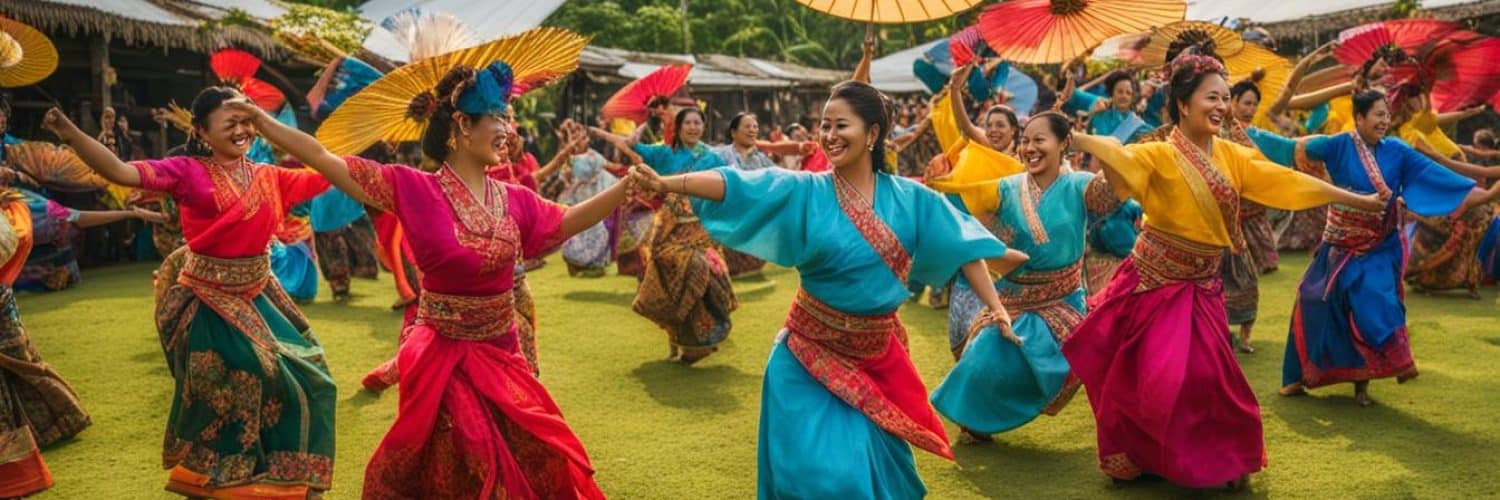Philippine folk dance is a rich and vibrant part of the country’s cultural heritage. These dances are performed to celebrate events and express cultural traditions, often accompanied by traditional music and songs. They vary in style and include both indigenous and Spanish-influenced forms. Some of the most popular Philippine folk dances include the tinikling, cariñosa, pandanggo sa ilaw, maglalatik, and singkil.
Key Takeaways:
- Explore the diverse and exciting world of Philippine folk dances.
- Experience the beauty and grace of traditional Filipino dances.
- Discover the origins and cultural significance of each dance.
- Appreciate the variety of styles and influences in Philippine folk dance.
- Immerse yourself in the rich tapestry of Philippine cultural heritage.
Tinikling – The National Dance of the Philippines
Tinikling is perhaps the most popular folk dance in the Philippines. It originated from Leyte’s province and is inspired by the graceful movement of tikling birds. The dance involves two dancers using bamboo poles to create rhythmic patterns. As the dancers skillfully maneuver the bamboo poles, they imitate the quick and agile movements of the tikling birds.
The tinikling dance showcases the agility, coordination, and precision of the dancers as they gracefully maneuver through and in between the bamboo. It requires both physical strength and nimbleness as the dancers jump, slide, and gracefully time their steps to avoid being caught by the closing poles. This captivating dance is not only a visual spectacle but also a test of skill and coordination for the performers.
Recognized as the national dance of the Philippines, tinikling holds great cultural significance and pride for the Filipino people. It is a representation of the country’s rich heritage and is often performed during festive occasions, cultural celebrations, and special events. The rhythmic beats created by the bamboo poles, combined with the dancers’ synchronized movements, capture the essence of Philippine folk dance traditions.
“Tinikling is a beloved dance that embodies the spirit, grace, and resilience of the Filipino people.” – Anonymous
Through the vibrant and energetic choreography of tinikling, the Filipino people express their identity, unity, and shared love for their cultural roots. It serves as a reminder of the country’s traditional values, history, and the resilience of its people. Tinikling remains a beloved and enduring symbol of Philippine cultural heritage and national pride.
Cariñosa – A Romantic Courtship Dance
Cariñosa is a beautiful and captivating Philippine courtship dance that originated from Panay Island. Rooted in the traditions of the Spanish colonial period, this dance represents the courtship gestures and mannerisms of Filipina women.
The Cariñosa dance is a graceful and elegant display of traditional Philippine movements. It showcases the beauty and fluidity of the dance form, captivating audiences with its romantic allure.
The dancers of Cariñosa perform flirtatious movements, accompanied by the gentle sway of a fan and a handkerchief. These movements reflect the gestures used by Filipina women to capture the attention and affection of their suitors during courtship.
With each step and graceful gesture, the dancers convey a sense of love, admiration, and respect. The Cariñosa dance takes the audience on a journey through the art of courtship, embracing the rich cultural heritage of the Philippines.
“Cariñosa embodies the spirit of romance and courtship, allowing us to connect with the traditions of our ancestors and appreciate the beauty of love expressed through movement.”
Elements of Cariñosa
| Movements | Props |
|---|---|
| Flirtatious gestures | Fans |
| Elegant footwork | Handkerchiefs |
| Graceful twirls | – |
During the Cariñosa dance, the intricate footwork and graceful twirls add an enchanting dimension to the performance. The dancers skillfully navigate the dance floor, conveying a sense of romance and harmony.
As the dancers move, they create a rhythmic melody with their footwork and the swishing sounds of the fans and handkerchiefs. The dance is a mesmerizing display of artistry, showcasing the beauty of Philippine courtship traditions.
The Cariñosa dance holds a special place in the hearts of Filipinos, as it symbolizes the rich cultural heritage and tradition of courtship in the Philippines. It serves as a reminder of the beauty of love and the artistry of the Philippine people.
Pandanggo sa Ilaw – Balancing Oil Lamps with Grace
Pandanggo sa Ilaw is a captivating Philippine cultural dance that originated from Lubang Island, Occidental Mindoro. This folk dance showcases the dancers’ skill and grace as they balance oil lamps or glasses with candles inside. The performers execute intricate movements while holding these lamps on their heads and palms, creating a mesmerizing spectacle of light and rhythm.
Accompanied by the delightful sound of castanets, Pandanggo sa Ilaw is known for its graceful choreography and intricate footwork. The dancers glide and pivot with precision, bringing the oil lamps to life through their expressive movements.
The graceful choreography and mesmerizing light of the oil lamps make Pandanggo sa Ilaw a breathtaking spectacle of Philippine cultural dance.
This dance form reflects the ingenuity and artistry of Philippine culture. The fusion of graceful movements and the balance required to hold the oil lamps adds a unique dimension to the performance, captivating audiences with its beauty and elegance.
Through the preservation and celebration of dances like Pandanggo sa Ilaw, the Philippines honors its rich cultural heritage, ensuring that future generations can appreciate and continue the legacy of this captivating artform.
Maglalatik – The Coconut Shell Dance
The Maglalatik is an energetic and captivating Philippine folk dance that showcases the unique creativity and rhythm of Filipino culture. Originating from Biñan, Laguna, this dance form features male dancers wearing coconut shell halves on their vests, adding a distinct visual and auditory element to the performance.
The Maglalatik dance tells the story of a playful mock battle over coconut meat, symbolizing the abundance and value of this tropical fruit in Filipino traditions. The dancers evoke a sense of excitement and camaraderie as they engage in rhythmic movements, skillfully striking and creating beats with the coconut shells.
This dynamic dance form highlights the athleticism and coordination of the performers, as they execute intricate footwork and synchronized movements. The energetic beats and vibrant costumes contribute to the lively and immersive experience of the Maglalatik.
The Maglalatik is not only a visually captivating performance but also a significant aspect of Philippine cultural heritage. It serves as a reminder of the importance of coconut in the daily lives of Filipinos and showcases the creativity and skill of the dancers.
Experience the rhythmic charm of the Maglalatik in this captivating performance:
| Movements | Description |
|---|---|
| Coconut Shell Strikes | The dancers strike the coconut shells together rhythmically, creating lively beats and percussions. |
| Footwork | Performers showcase intricate, synchronized footwork, highlighting their agility and coordination. |
| Mock Battle | Dancers engage in playful mock battles, simulating a competition for the coconut meat. |
| Fluid Movements | The dancers’ movements are fluid and dynamic, representing the joy and vibrancy of Filipino culture. |
Witness the energy and liveliness of the Maglalatik as the dancers create rhythmic beats and engage in a playful mock battle over coconut meat. This captivating dance form is a testament to the rich cultural heritage of the Philippines and is a must-see for anyone seeking an immersive experience into Filipino traditions.
Singkil – A Majestic Maranao Dance
Singkil is a traditional dance from the Maranao people of Mindanao. This captivating dance tells the story of Princess Gandingan, who navigates through falling trees during an earthquake caused by forest nymphs. The dancers gracefully move in and out of crossed bamboo poles, depicting the Princess’s journey. Singkil is a visually stunning dance that showcases the rich culture of the Maranao people.
The Singkil dance is deeply rooted in Maranao mythology and history. It is performed on various occasions, such as weddings, festivals, and cultural events. The dance is accompanied by traditional gongs and drums, adding to the rhythmic beauty of the performance.
Singkil requires precision and coordination as the dancers skillfully maneuver through the intricate patterns of the crossed bamboo poles. The gracefully synchronized movements of the performers, combined with their colorful costumes and elaborate headpieces, create a mesmerizing visual spectacle for the audience.
This cultural treasure showcases the traditions and artistic expressions of the Maranao people. It not only entertains but also preserves the heritage and values of the community. Singkil serves as a reminder of the resilience and strength of the Maranao people, who have preserved their cultural practices throughout centuries of history.
Sayaw sa Bangko – Dancing on Wooden Benches
Sayaw sa Bangko, also known as “dancing on a chair,” is a lively dance performed on top of a narrow wooden bench. Originating from Pangasinan, it is traditionally performed by newlyweds during wedding feasts. The dancers showcase their balance and agility while dancing on the six-inch-wide bench. Sayaw sa Bangko is a joyful and energetic celebration of love and unity.
Highlights of Sayaw sa Bangko
- A traditional Philippine wedding dance
- Performed on top of a narrow wooden bench
- Showcases balance, agility, and coordination
- Originates from Pangasinan
During the Sayaw sa Bangko, the dancers display impressive footwork and skillful movements while gracefully balancing on the bench. The dance symbolizes the harmony and partnership between the newlyweds as they embark on their journey together.
This Philippine wedding dance requires precision and synchronization, as the dancers step, glide, and leap with remarkable grace and control. The performers engage in intricate patterns and formations, showcasing their agility and keeping the audience captivated.
Sayaw sa Bangko is accompanied by lively, traditional music that complements the energetic movements of the dancers. The beat and rhythm of the music add to the festive atmosphere, creating a joyful ambiance during wedding celebrations.
Weddings in the Philippines are vibrant and festive occasions, filled with love, laughter, and colorful traditions. Sayaw sa Bangko is one such tradition, bringing excitement and entertainment to the wedding feasts.
| Key Elements of Sayaw sa Bangko | Description |
|---|---|
| Movement | Graceful steps, precise footwork, and coordinated formations |
| Music | Lively and traditional music that adds to the festive atmosphere |
| Symbolism | Representing the unity and harmony of the newlyweds |
| Traditional Attire | Colorful and stunning traditional garments |
By participating in Sayaw sa Bangko, the newlyweds not only honor their cultural heritage but also create a memorable experience for themselves and their guests. It is a testament to the enduring traditions and celebrations that make Philippine weddings truly special and unique.
Kuratsa – A Courtship Dance from Samar Island
Kuratsa is a captivating courtship dance that originated from Samar Island, Philippines. It showcases the intricate mating movements of a rooster and a hen, symbolizing the traditional Filipino courtship rituals. The dance consists of three distinct parts, each representing a different stage of courtship.
The first part of Kuratsa is a waltz, where the male and female dancers gracefully move together, expressing their initial attraction and connection. It is a beautiful display of harmony and synchronization, setting the tone for the rest of the dance.
In the second part, the male dancer pursues the female dancer with passion and determination. The chase between the two dancers is intense and energetic, symbolizing the pursuit of love. Their movements become more dynamic and spirited, reflecting the excitement and desire of courtship.
Finally, the dance concludes with the male winning over the female. This represents triumph and success in courtship, as the male dancer successfully captures the heart of the female dancer. It is a joyful moment that celebrates the beginning of a romantic relationship.
Kuratsa is renowned for its lively and expressive movements, characterized by quick footwork, graceful gestures, and vibrant costumes. The dancers’ coordination and chemistry are essential in creating a mesmerizing performance that captivates audiences.
“Kuratsa is a lively and expressive dance that reflects the rich cultural heritage of the Philippines.”
Subli – A Religious Dance from Batangas
Subli is a sacred folk dance that holds deep religious significance in Batangas, Philippines. It is performed as a spiritual tribute to the Holy Cross of Alitagtag, emphasizing the strong religious devotion and cultural heritage of the region.
During Subli, experienced male and female dancers come together to create a mesmerizing display of coordinated movements. They hop and slide in rhythmic patterns, synchronizing their steps with precise timing and graceful agility. The dancers wear traditional attire that reflects the rich cultural traditions of Batangas.
The male dancers play a vital role in Subli, as they beat castanets, adding a rhythmic and enchanting element to the performance. The sound of the castanets resonates through the air, enhancing the spiritual and hypnotic ambiance of the dance. Meanwhile, the female dancers gracefully sway, their movements accentuated by the elegant brimmed hats they hold in their hands.
This religious dance showcases the seamless integration of spirituality and artistic expression. It reflects the deep-rooted faith and unwavering devotion of the Batangueños, who celebrate their cultural heritage with reverence and joy.
Through Subli, the people of Batangas express their devotion to the Holy Cross while preserving and celebrating their distinctive cultural traditions. It is a remarkable display of unity, faith, and artistic talent.
“Subli is not just a dance; it is a profound expression of our faith and love for our cultural heritage. It reminds us of our deep spiritual roots and connects us to our ancestors, who passed down these traditions through generations.” – Maria Santos, a Batangas native.
Itik-Itik – The Dance of the Ducks
Itik-Itik is a captivating Philippine folk dance that takes inspiration from the movements of ducks. Originating from Surigao del Sur, this lively and engaging dance showcases the creativity and ingenuity of traditional Philippine dance forms.
The Itik-Itik dance is named after the Itik species, which means “duck” in English. The dancers mimic the playful movements of ducks, imitating how they walk, fly, and even splash water. This unique dance form beautifully captures the grace and agility of these birds, adding a touch of charm and excitement to the performance.
The Itik-Itik dance is characterized by fluid and flowing movements, as the dancers gracefully glide across the stage. They use their arms and hand gestures to mimic the wings of a duck, while their footwork replicates the delicate steps of these feathered creatures. The playful and rhythmic motions create an enchanting performance that captivates the audience’s attention and leaves them in awe.
Itik-Itik is often accompanied by lively traditional music featuring rhythmic beats and melodic tunes. The combination of the vibrant dance movements and the uplifting music creates an immersive experience that celebrates the beauty of Philippine culture.
This bird-inspired dance is not only entertaining but also holds cultural significance in the Philippines. It reflects the deep connection between nature and dance, as well as the resourcefulness and creativity of the Filipino people. The Itik-Itik dance is a testament to the diverse range of folk dances and traditions that make up the rich tapestry of Philippine heritage.
Symbolism of the Itik-Itik Dance
The Itik-Itik dance is more than just an artistic expression. It also carries layers of symbolism that add depth and meaning to the performance. The playful movements imitating ducks not only showcase the grace and agility of these birds but also represent the resilience and adaptability of the Filipino people. Just like ducks effortlessly glide through water, the dance reflects the ability to navigate through life’s challenges with grace and ease.
Furthermore, the Itik-Itik dance offers a way to connect with nature and pay homage to the country’s agricultural roots. As ducks are a common presence in rice fields, their movements in the dance resemble the rhythm and harmony of farming practices in rural communities.
The Itik-Itik dance is truly a cultural treasure and a testament to the unique and captivating traditions of the Philippines. By embracing and sharing this dance form, the Filipino people continue to preserve their heritage and celebrate their vibrant cultural identity.
| Key Features of Itik-Itik | Description |
|---|---|
| Mimicked Movements | The dance imitates the playful movements of ducks, including walking, flying, and splashing water. |
| Fluid Footwork | The dancers showcase delicate and flowing footwork that replicates the graceful steps of ducks. |
| Immersive Performance | The combination of captivating movements, lively music, and colorful costumes creates a mesmerizing experience for the audience. |
| Cultural Significance | The Itik-Itik dance symbolizes the resilience and adaptability of the Filipino people, as well as their deep connection with nature and agricultural traditions. |
La Jota Moncadeña – A Spanish-Inspired Dance
La Jota Moncadeña is a captivating Philippine dance that draws inspiration from the traditional Spanish Jota. This unique dance form combines Ilocano and Spanish dance steps, creating a vibrant fusion of cultures. Accompanied by the rhythmic sound of castanets and traditional Spanish music, La Jota Moncadeña showcases the influence of Spanish colonial history on Philippine dance.
This lively dance is typically performed at special celebrations and cultural events in the Philippines. Dancers display intricate footwork, graceful movements, and expressive gestures, reminiscent of the Spanish influence on Philippine culture. La Jota Moncadeña is not only a form of artistic expression but also a way to honor and celebrate the shared history between the Philippines and Spain.
The fusion of Ilocano and Spanish dance steps in La Jota Moncadeña creates a captivating visual spectacle. Dancers often wear traditional attire that reflects the Spanish colonial era, complete with vibrant colors and intricate designs. The rhythmic sounds of the castanets add an enchanting element to the performance, enhancing the overall cultural experience.
Watching La Jota Moncadeña is a journey through time, as it showcases the enduring legacy of Spanish influence on Philippine arts and culture. The dance form has evolved over the years, adapting to the unique cultural context of the Philippines while retaining its Spanish roots. It serves as a testament to the resilience and adaptability of Philippine traditions.
La Jota Moncadeña is not only a dance but also a celebration of cultural diversity, representing the Philippines’ rich and nuanced heritage. Through this dance, we can appreciate the amalgamation of indigenous and Spanish influences that have shaped Philippine culture. La Jota Moncadeña stands as a testament to the country’s vibrant past and its embrace of cultural exchange.
Conclusion
Philippine folk dances are a significant part of the country’s cultural heritage. They represent the diversity and richness of Philippine traditions and history. These dances, such as tinikling and cariñosa, beautifully showcase the unique stories and beauty of Filipino culture.
By exploring and appreciating these folk dances, we can gain a deeper understanding and connection to the vibrant tapestry of Philippine heritage. Each dance tells its own story and carries the spirit of the Filipino people.
From the rhythmic movements of tinikling to the elegant grace of cariñosa, these dances offer a glimpse into the traditions and values that shape Filipino identity. It is through the preservation and celebration of Philippine folk dances that we honor the past and inspire future generations to embrace their cultural heritage.
FAQ
What are Philippine folk dances?
Philippine folk dances are traditional dance forms that represent the cultural heritage of the Philippines. These dances are performed to celebrate events and express cultural traditions, accompanied by traditional music and songs.
How many types of Philippine folk dances are there?
There are numerous Philippine folk dances, but some of the most popular ones include tinikling, cariñosa, pandanggo sa ilaw, maglalatik, and singkil. In total, there are 16 best-known Philippine folk dances that showcase the diverse culture of the country.
What is the national dance of the Philippines?
The national dance of the Philippines is tinikling. Inspired by the movement of tikling birds, this dance involves two dancers using bamboo poles to create rhythmic patterns. Tinikling is considered a significant part of the country’s cultural identity.
What is cariñosa?
Cariñosa is a traditional Philippine folk dance that represents the courtship gestures and mannerisms of Filipina women during the Spanish colonial period. It is a graceful dance that showcases the beauty and fluidity of traditional Philippine movements.
What is pandanggo sa ilaw?
Pandanggo sa ilaw is a folk dance from Lubang Island, Occidental Mindoro. It involves balancing oil lamps or glasses with candles inside. The dancers perform intricate movements while holding the lamps on their heads and palms. This dance is known for its graceful and mesmerizing choreography.
Can you tell me about maglalatik?
Maglalatik is a unique folk dance that features male dancers wearing coconut shell halves on their vests. Originating from Biñan, Laguna, it depicts a mock battle over coconut meat. Maglalatik is an energetic and captivating dance form that showcases lively movements and rhythmic beats with the coconut shells.
What is singkil?
Singkil is a traditional dance from the Maranao people of Mindanao. It tells the story of Princess Gandingan, who navigates through falling trees during an earthquake caused by forest nymphs. The dancers gracefully move in and out of crossed bamboo poles, depicting the Princess’s journey. Singkil is a visually stunning dance and a reflection of the rich culture of the Maranao people.
What is sayaw sa bangko?
Sayaw sa bangko, also known as “dancing on a chair,” is a lively dance performed on top of a narrow wooden bench. Originating from Pangasinan, it is traditionally performed by newlyweds during wedding feasts. The dancers showcase their balance and agility while dancing on the six-inch-wide bench. Sayaw sa bangko is a joyful and energetic celebration of love and unity.
What is kuratsa?
Kuratsa is a courtship dance that originated from Samar Island. It portrays the mating movements of a rooster and a hen. The dance consists of three parts, including a waltz, a chase between the male and female dancer, and a conclusion where the male wins over the female. Kuratsa is a lively and expressive dance that reflects the rich cultural heritage of the Philippines.
Can you tell me about subli?
Subli is a religious folk dance performed in honor of the Holy Cross of Alitagtag in Batangas. It involves experienced male and female dancers who hop and slide in rhythmic patterns. The male dancers beat castanets, while the female dancers sway gracefully while holding their brimmed hats. Subli combines spirituality and artistic expression in a significant dance form.
What is the Itik-Itik dance?
Itik-Itik is a folk dance that imitates the movements of ducks. It originated from Surigao del Sur and is named after the Itik species. The dance incorporates playful movements inspired by how ducks walk, fly, and splash water. Itik-Itik is a lively and engaging dance that showcases the creativity and ingenuity of traditional Philippine dance forms.
What is La Jota Moncadeña?
La Jota Moncadeña is a Philippine adaptation of the traditional Spanish Jota dance. It incorporates Ilocano and Spanish dance steps accompanied by castanets and traditional Spanish music. La Jota Moncadeña is typically performed at special celebrations and is a vibrant representation of the country’s Spanish colonial history.


















Add comment